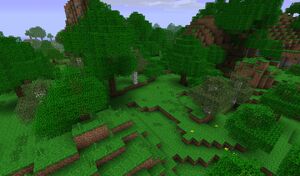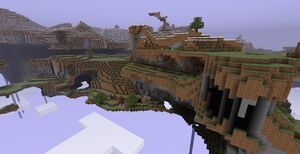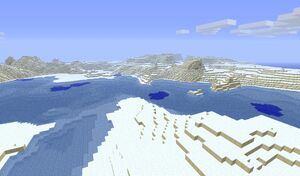In Beta 1.8 and TU5, biomes received a major overhaul, removing and changing many biomes.
Biome types

Pre-1.8 example of Biomes
Before the Adventure Update and TU5, biomes were much smaller and less distinct.
Biome placement was controlled by temperature and humidity values (like 1.7+), allowing interface biomes and making it nearly impossible to generate desert near taiga or rain forest near tundra (except ice desert) while making transitions from biome to biome smoother. Tall grass was also much less present in pre-1.8 worlds (except in the "Plains" and "Ranforest" biomes).
There were 13 biome types: 10 in the Overworld, 1 in the Nether, and 2 unused ones that are in the code but aren't encountered in normal play.
| Biome | Characteristics | Image |
|---|---|---|
| Rain Forest | Rainforests are very wet biomes with many trees, which have a 1/3 chance of being big. They only generate oak trees, and have a large amount of tall grass, some of which is switched to ferns. They spawn with a temperature greater than 97/100, and a humidity greater than 90/100 as referenced in the code. In the world generator, this could be the biome with some of the most cliffs and hills, because the noise octaves base the amount of terrain variation on humidity. | 
|
| Seasonal Forest | Seasonal Forests spawn with a temperature of 97/100 or greater, and a humidity value between 45/100 and 90/100. They are commonly found between forest and rain forests, and near plains biomes. They are identical to forests, except they have less trees and are only capable of spawning oak trees. They have a little bit of tall grass. | 
|
| Forest | A biome with many trees and a little bit of tall grass. Wolves can spawn here. Forest is the only biome where birch trees spawn. It generates when the temperature is between 50/100 and 97/100, and the humidity is 35/100 or greater. | 
|
| Swampland | Identical to shrubland with only the unused color variables and the biome name differing. It generates when the temperature is between 10/100 and 70/100, and a humidity is between 50/100 and 90/100. Because 50/100 temperature is snow temperature, the swamp biome can have snow (although it will not regenerate and will rain instead of snow). Despite most of the temperature range of swamplands being below 50/100, the way the humidity is multiplied by the temperature prevents most of this, and most of the swampland does not have snow. Because the humidity value expected for a swampland to spawn is above 50/100, it is most likely that the temperature is higher than 50/100 for the humidity to be in the range required for swamplands. | 
|
| Savanna | A biome with mostly flat terrain and almost no trees, although some hills do spawn. It seems to be one of the flattest biomes in the game, alongside desert and tundra. The grass color can range from dull orange to blue-ish gray. It generates with a temperature between 50/100 and 95/100, and a humidity value of less than 20/100. | 
|
| Shrubland | A biome with some trees and dull colored grass. Usually found at the interface between forest and savanna. No tall grass can be generated here. | 
|
| Taiga | A snowy biome composed of mostly mountainous terrain and very few tall grass. Spruce and pine trees as well as ice can be found in this region. Wolves also appear more commonly on this biome than others. Snow is a common weather in taiga biomes. In Beta 1.8 and 1.0, Taiga biomes generated without ice and/or snow due to a bug. | 
|
| Desert | A biome consisting mostly of sand, dead shrubs and cacti. Trees do not generate in deserts unless the player brings in dirt. No rain occurs in this biome.
Since Beta 1.0 and before Beta 1.4 desert borders were rotated and didn't line up because of a bug. |

|
| Plains | A very flat biome with a very large amount of tall grass (more than in any other type of land). The occasional trees do exist, though very rarely. | 
|
| Tundra | Snowy, barren terrain with very few trees. The occasional trees do exist, though very rarely. Ice can be found over water. Snow is a common weather in tundras.
In 1.8, Notch also said this biome would be left out until 1.9. This is because snow was causing problems with the new biome generator. |

|
| Sky | A hidden biome before 1.9pre4, this biome was exclusive to, and the sole biome of the Sky Dimension. It would generate floating islands with oceans of air surrounding them. Trees were uncommon. No weather occurred here. It had small patches of snow, although it would not accumulate again. It had green with some extra blue hue for foliage colors.
This biome was introduced in Beta 1.6 along with the Sky Dimension itself. It was reintroduced for The End's biome though. |

|
| Ice Desert (corner case biome) | A biome in the code before 1.8 that was supposed to generate at maximum coldness and dryness, but did not actually generate due to bugs. It was a biome of sand with snow on top of it and had snowfall and ice. | 
|
Generated structures
| Structure | Characteristics | Image |
|---|---|---|
| Hills/Cliffs | Mountains are hills with extreme slopes. Prior to the 1.8 update, these highly mountainous landforms were found in all type of biomes, but from the Adventure Update onwards are very rare outside the Extreme Hills and Mesa biomes. They were generated as part of the terrain generation algorithm.
Cliffs are often carved into hills, and sometimes have caves protruding into them. These caves contain the same blocks which one would find at the same layer in the hill they are carved out of. |
 |
| Ocean | Oceans are huge bodies of water with every single water tile being a spring. Prior to the Adventure Update, oceans were generated as part of the terrain generation algorithm, but since then they are part of the Ocean biome. | 
|
| Beaches | Beaches are usually generated next to oceans or lakes and covered all nearby low elevated shorelines. They could be found in any biome. They came in two varieties: sand beach and gravel beach. Sandstone was located below sand in sand beaches.
Gravel beaches had no such border and thus posed dangers like falling into caverns located right underneath them. Due to the changes in the terrain generation algorithm in the Beta 1.8 update beaches were removed completely from the game. |
 |

